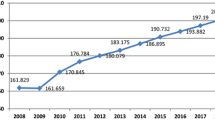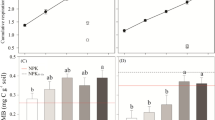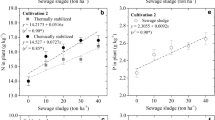Abstract
Sewage sludge, a waste material commonly known as biosolids, has good potential as a valuable agricultural resource, providing that its nutrient imbalances could be overcome. Sewage sludge is rich in phosphorus but low in nitrogen and potassium. Technology exists to supplement sewage sludge with mineral fertilizers, such as urea and muriate of potash as sources of nitrogen and potassium, respectively, to produce an organo-mineral fertilizer with balanced crop nutrient requirements. Here, an experimental plot trial set up in 2008 was established at Broxton, Cheshire, UK, to compare crop yield response for typical crop varieties. Crops included wheat, oilseed rape, barley, beans and forage maize, treated with conventional fertilizer and organo-mineral fertilizer. The organo-mineral fertilizer is a nutrient-balanced sludge-based product produced by drying digested sewage sludge cake at 80 °C in a tumbling evaporator, which produces sludge granules of 3–6 mm in diameter. Analysis was carried out on soil NPK and crop yield. N use efficiency was measured to assess N uptake. Results show that there is no significant difference in crop yield between treatments over the three trial years, with the exception of one crop. This finding demonstrates that the new organo-fertilizer is as efficient as conventional fertilizers. Moreover, levels of heavy metal in soil did not exceed permissible levels. The novelty of this research lies in the fact that it is the first field scale trial of a modified sewage sludge product that has the potential to transform a hitherto waste product into a practical fertilizer product. We conclude that the organo-mineral fertilizer is a promising alternative product for sustainable agriculture.





Similar content being viewed by others
References
Ailincăi D, Ailincăi C, Zbant M, Mercus A, Topa D (2008) Influence of organo-mineral fertilization on wheat and maize crops and the evolution of soil fertility under long-term experiments in the Moldavian Plain. Cercetări Agronomic în Moldova MLI, no. 3(135):33–42
Alley MM, Scharf P, Brann DE, Baethgen EW, Hammons JL (2009) Nitrogen management for winter wheat: principles and recommendations. Virginia Cooperative Extension, publication 424–026. http://pubs.ext.vt.edu/424/424-026/424-026.html. Accessed 8 June 2012
Antille DL (2011) Formulation, utilisation and evaluation of organiomineral fertilisers. EngD Thesis, Cranfield University
Ayeni LS, Adeleye EO, Adejumo JO (2012) Comparative effect of organic, organomineral and mineral fertilizers on soil properties, nutrient uptake, growth and yield of maize (Zea mays). Int Res J Agric Sci Soil Sci 2(11):493–497
CEC (1991) Council of the European Communities, 1991a. Council Directive concerning the protection of water against pollution caused by nitrates from agricultural sources. Council Directive of 31 December 1991 (91/676/EEC). Off J Eur Communities L375:1–5
CEC (1999) Council Directive 99/31/EC of 26 April 1999 on the landfill of waste. Off J Eur Communities L182:1–19
Cordell D, Drangert J-O, White S (2009) The story of phosphorus: global food security and food for thought. Glob Environ Chang 19:292–305. doi:10.1016/j.gloenvcha.2008.10.009
Defra (2010) Fertiliser manual (RB209), 8th edn. Defra Publication, The Stationery Office, Norwich
Edge D (1999) Perspectives for nutrient removal from sewage sludge and implications for sludge strategy. Environ Technol 20:759–763. doi:10.1080/09593332008616871
Environment Agency (EA) (2004) The state of soils in England and Wales. Environment Agency, Rio House
European Environment Agency (2005) Sewage sludge—a future waste problem? Indicator Fact Sheet Signals 2001. http://www.eea.europa.eu/data-and-maps/indicators/generation-and-treatment-of-sewage-sludge. Accessed 8 Jun 2012
FAO (2007) Food and Agricultural Organization of the United Nations, 2007. Database on commercially available organic fertilizers and water-retaining products. Land and Water Development Division. Accessed 5 Dec 2012 http://www.fao.org/AG/aGL/agll/orgfert/intro.stm
Gedara S, Le MS, Murray C, Tyrrel S, Godwin R (2009) Farm scale crop trials of SMART-P Organo mineral fertilisers. 14th European Biosolids and Organic Resources Conference and Exhibition. Leeds
Gendebien, A., Davis, B., Hobson, J., Palfrey, R., Palfrey, R., Pitchers, R., Rumsby, P., Carlton-Smith, C. & Middleton, J. (2010) Environmental, economic and social impacts of the use of sewage sludge on land. Final Report. Project III. Project Interim Reports. European Commission, DG ENV.G.4/ETU/2008/0076r
Gibbs PA, Chambers BJ, Chaudri AM, McGrath SP, Carlton-Smith CH, Bacon JR, Campbell C, Aitken MN (2006) Initial results from a long-term, multi-site field study of the effects on soil fertility and microbial activity of sludge cakes containing heavy metals. Soil Use Manage 22:11–21. doi:10.1111/j.1475-2743.2006.00003.x
Godfray HCJ, Beddington JR, Crute IR, Haddad L, Lawrence D, Muir JR, Pretty J, Robinson S, Thomas SM, Toulmin C (2010) Food security: the challenge of feeding 9 billion people. Science 327:812–818
Gomiero T, Pimentel D, Paoletti MG (2011) Is there a need for a more sustainable agriculture? Crit Rev Plant Sci 30(1–2):6–23
Hilton JK, Johnston AE, Dawson CJ (2010) The phosphate life-cycle: rethinking the options for a finite resource. International Fertiliser society proceedings, York
ISO 10390 (1994) Soil quality—determination of pH. International Organization for Standardization, Geneva, p 5
ISO 11047 (1998) Soil quality—determination of cadmium, chromium, cobalt, copper, lead, manganese, nickel and zinc. Flame and electrothermal atomic absorption spectrometric methods. International Organization for Standardization, Geneva, p 6
Johnston AE (2008) Resource or waste: the reality of nutrient recycling to land. Proceeding No. 630 of The International Fertiliser Society, York, YO32 5YS, UK
Johnston AE, Poulton PR (2009) Nitrogen in agriculture: an overview and definitions of nitrogen use efficiency. Proceeding No. 651 of The International Fertiliser Society, York, YO32 5YS, UK
Johnston AE, Wedderburn RWM (1974) The Woburn Market Garden Experiment, 1942–69 I. A history of the experiment, details of the treatments and the yields of the crops. Rothamsted Report for 1974, Part 2. Rothamsted
MAFF (2000) Fertiliser recommendations for agricultural and horticultural crops (RB209), Ministry of Agriculture, Fisheries and Food, The Stationary Office, PO Box 29, Norwich NR3 1GN
MAFF (1986) The analysis of agricultural materials, 3rd edn, Reference Book 427. The Stationery Office, London
MAFF (1998) Code of good agricultural practice for the protection of soil (Revised, 1998). The Stationery Office, London
Murphy J, Riley JP (1962) A modified single solution method for the determination of phosphate in natural waters. Anal Chim Acta 27:31–36
Nicholson FA, Smith SR, Alloway BJ, Carlton-Smith C, Chambers BJ (2006) Quantifying heavy metal inputs to agricultural soils in England and Wales. Water Environ J 20:87–95. doi:10.1111/j.1747-6593.2006.00026.x
Nix J (2011) Farm management pocketbook, 41st edn. Imperial College, The Anderson Centre, London
Petersen SO, Henriksen K, Mortensen GK, Krogh PH, Brandt KK, Sørensen J, Madsenf T, Petersen J, Grønc C (2003) Recycling of sewage sludge and household compost to arable land: fate and effects of organic contaminants and impact on soil fertility. Soil Tillage Res 72:139–152
Petts J (1994) Incineration as a waste management option. In: Hester RE, Harrison RM (eds) Waste incineration and the environment. Royal Society of Chemistry, Cambridge
Pretty J (2002) Agri-culture: reconnecting people, land and nature. Earthscan, London
Pretty J (2008) Agricultural sustainability: concepts, principles and evidence. Phil Trans B 363:447–465
Pretty J, Toulmin C, Williams S (2011) Sustainable intensification in African agriculture. Int J Agric Sustain 9(1):5–24
Ragg JM, Beard GR, George H, Heaven FW, Hollis JM, Jones RJA, Palmer RC, Reeve MJ, Robson JD, Whitfield WAD (1984) Soils and their use in Midland and Western England. Soil Survey of England and Wales, Bulleting No. 12, Harpenden, p. 433
Royal Society of London (2009) Reaping the benefits: science and the sustainable intensification of global agriculture. RS Policy document 11/09 Issued: October 2009 RS1608, London. http://royalsociety.org/Reapingthebenefits/ Accessed 16 Jul 2012
Smith SR (2008) The implications for human health and environment of recycling biosolids onto agricultural land. Centre for Environmental Control and Waste Management Imperial College London, London, pp 76–7
Sommers LE (1977) Chemical composition of sewage sludges and analysis of their potential use as fertilizers. J Environ Qual 6:225–232
Wei Y, Van Houten RT, Borger AR, Eikelboom DH, Fan Y (2003) Minimisation of excess sludge production for biological wastewater treatment. Water Res 37:4453–4467. doi:10.1016/S0043-1354(03)00441-X
Acknowledgments
The research leading to these results has received funding from the European Union Seventh Framework Programme (FP7-ENV.2010.3.1.1-2 ENV) under grant agreement no. 265269. http://www.end-o-sludg.eu/. We acknowledge the support of the Technology Strategy Board for funding this research together with United Utilities Water PLC under the Knowledge Transfer Partnership. We would also like to extend our thanks to the farmers for allowing access to their land and for their support to the research programme. The authors would like to thank United Utilities Water PLC for permission to publish this paper. The paper represents the opinion of the authors and does not necessarily represent the view of the European Union or United Utilities Water PLC.
Author information
Authors and Affiliations
Corresponding author
About this article
Cite this article
Deeks, L.K., Chaney, K., Murray, C. et al. A new sludge-derived organo-mineral fertilizer gives similar crop yields as conventional fertilizers. Agron. Sustain. Dev. 33, 539–549 (2013). https://doi.org/10.1007/s13593-013-0135-z
Accepted:
Published:
Issue Date:
DOI: https://doi.org/10.1007/s13593-013-0135-z




